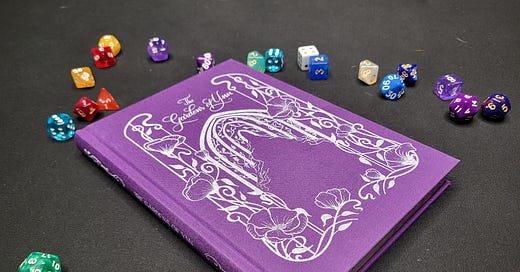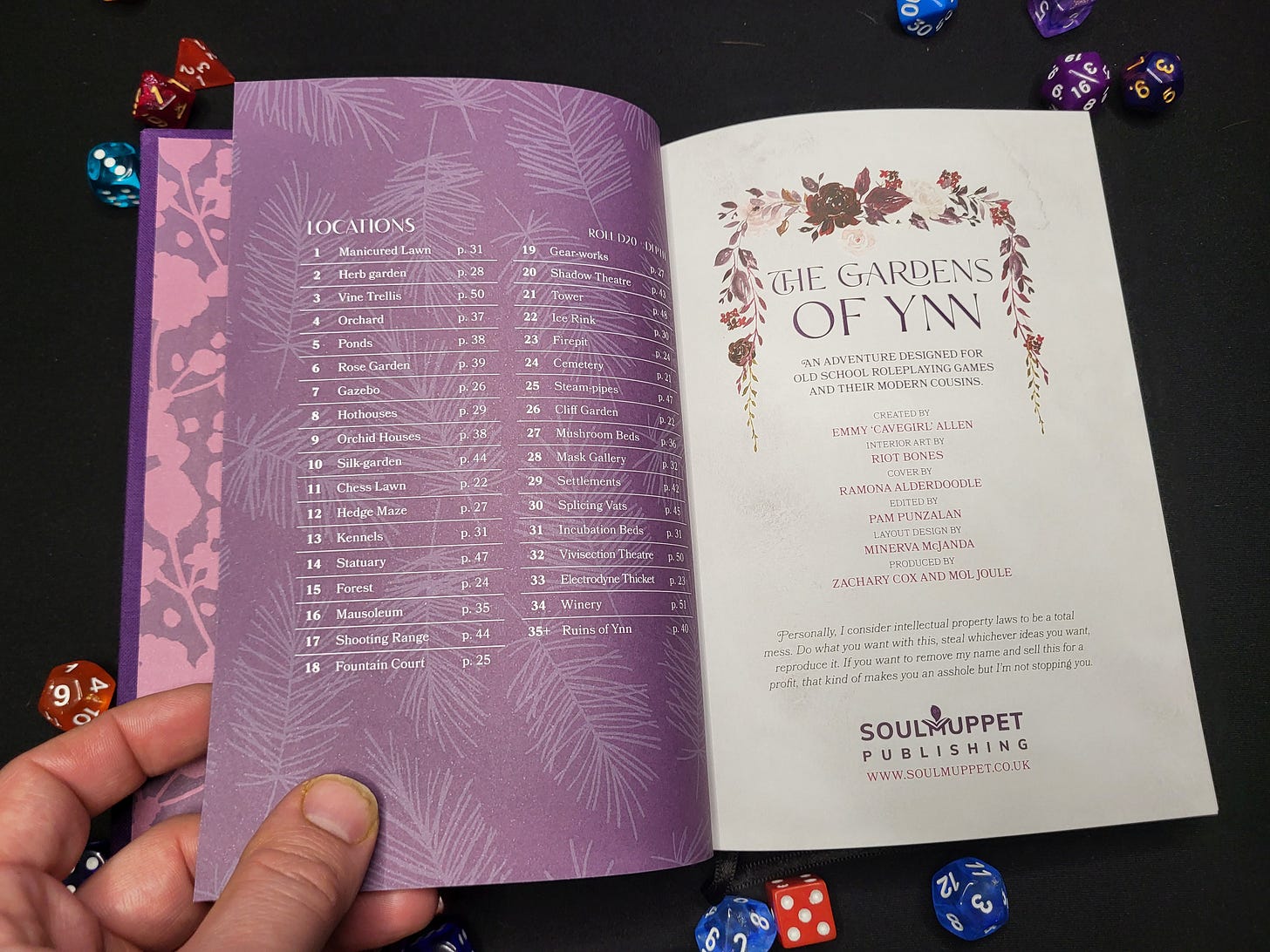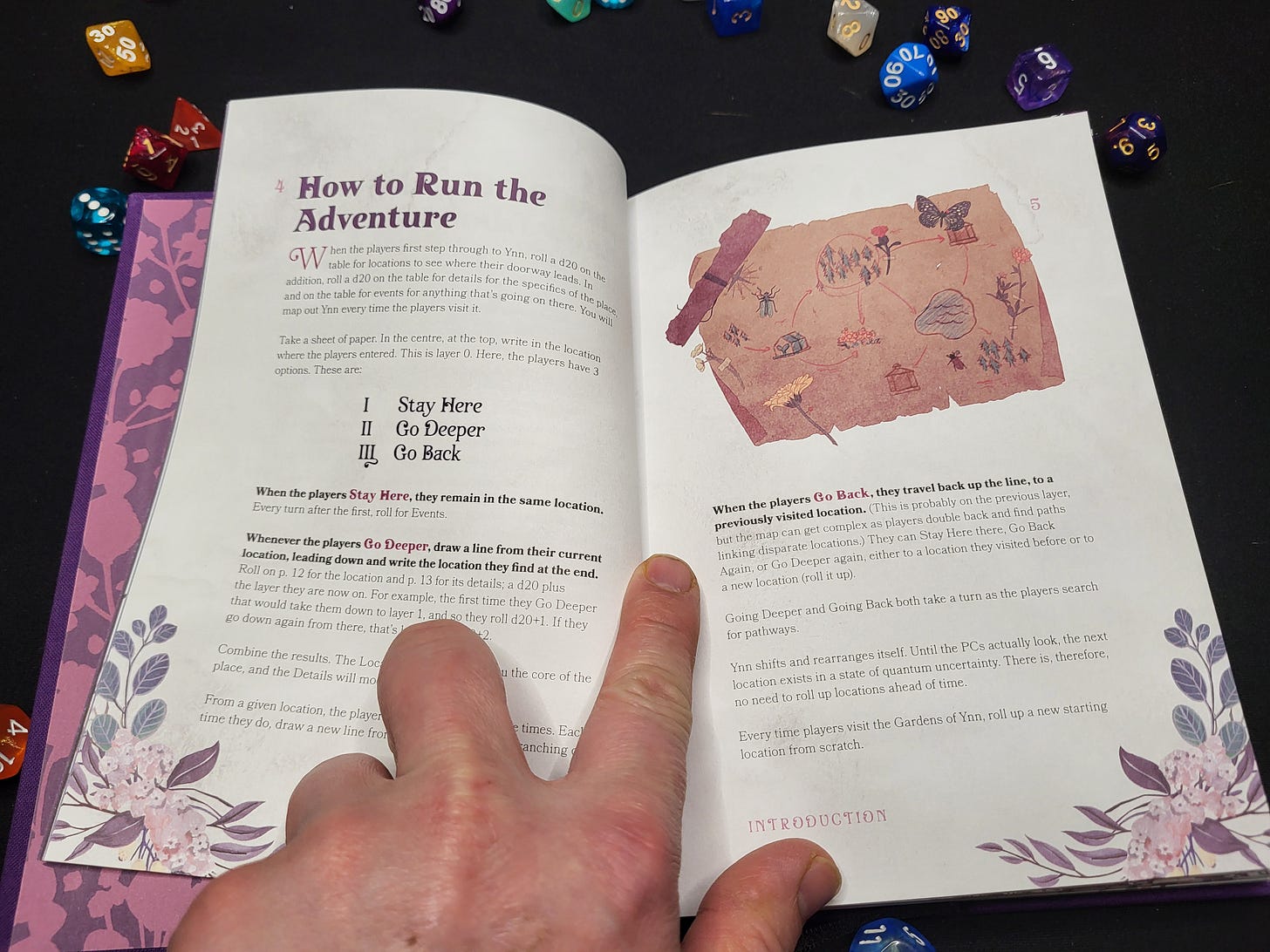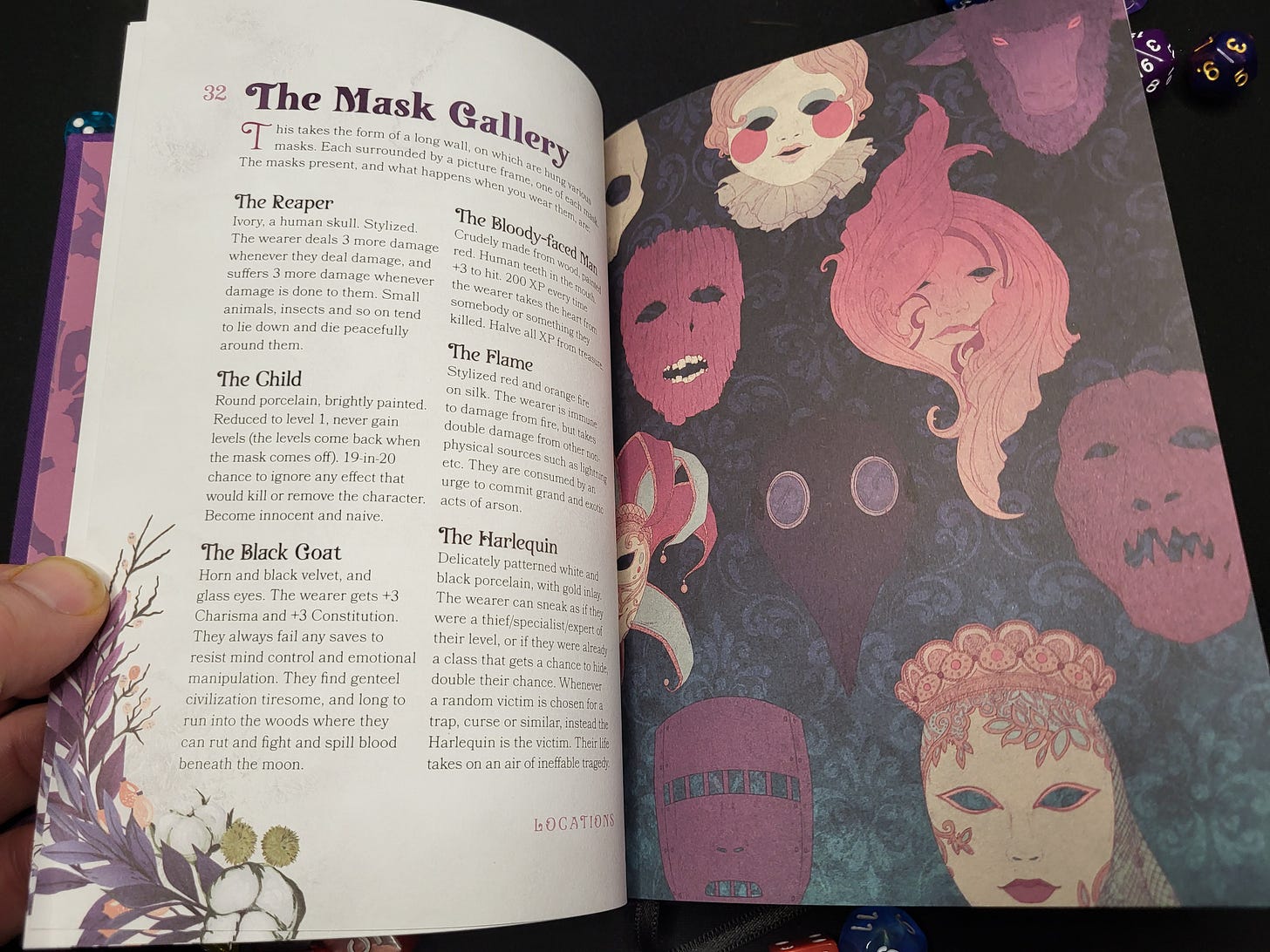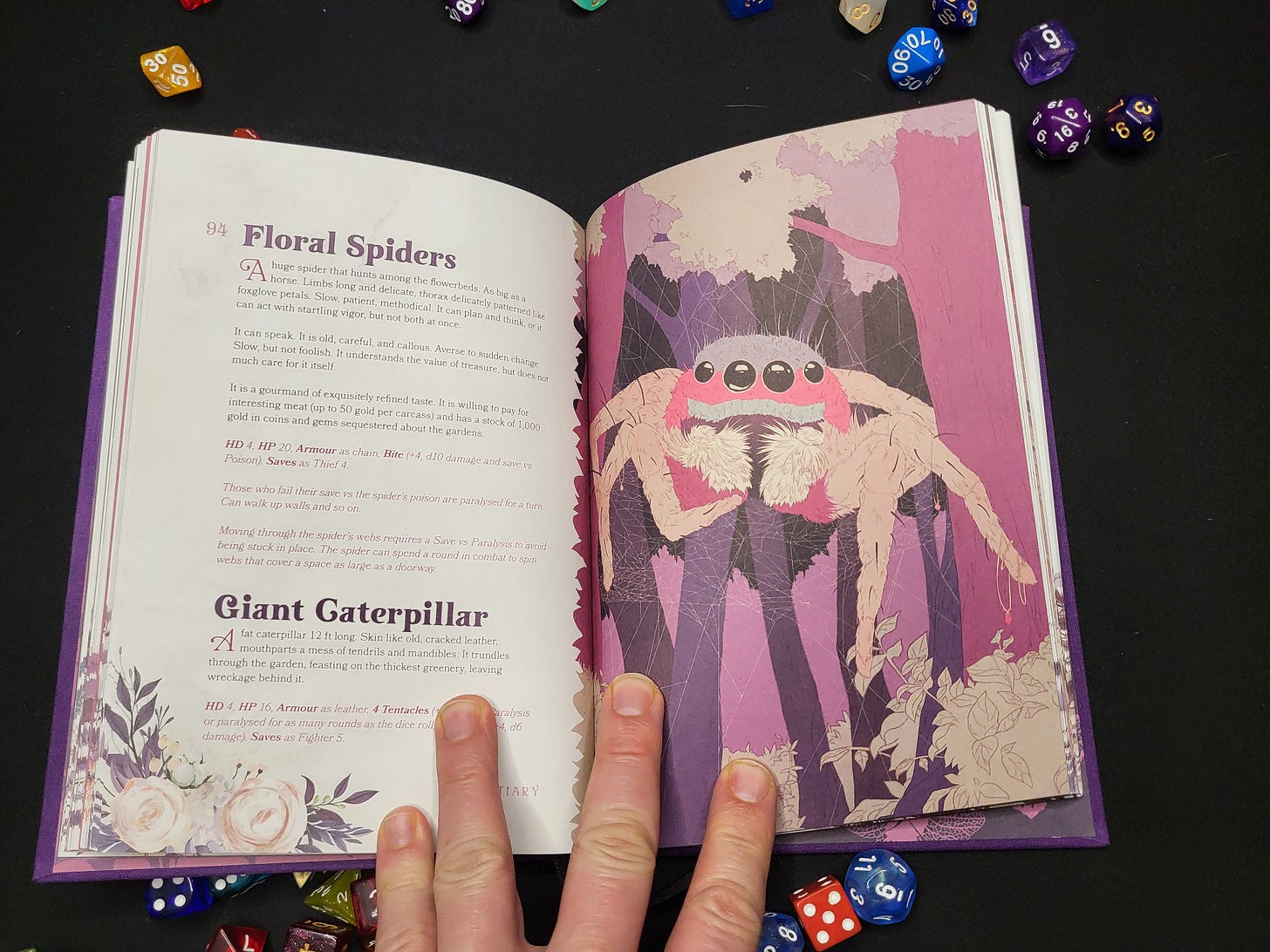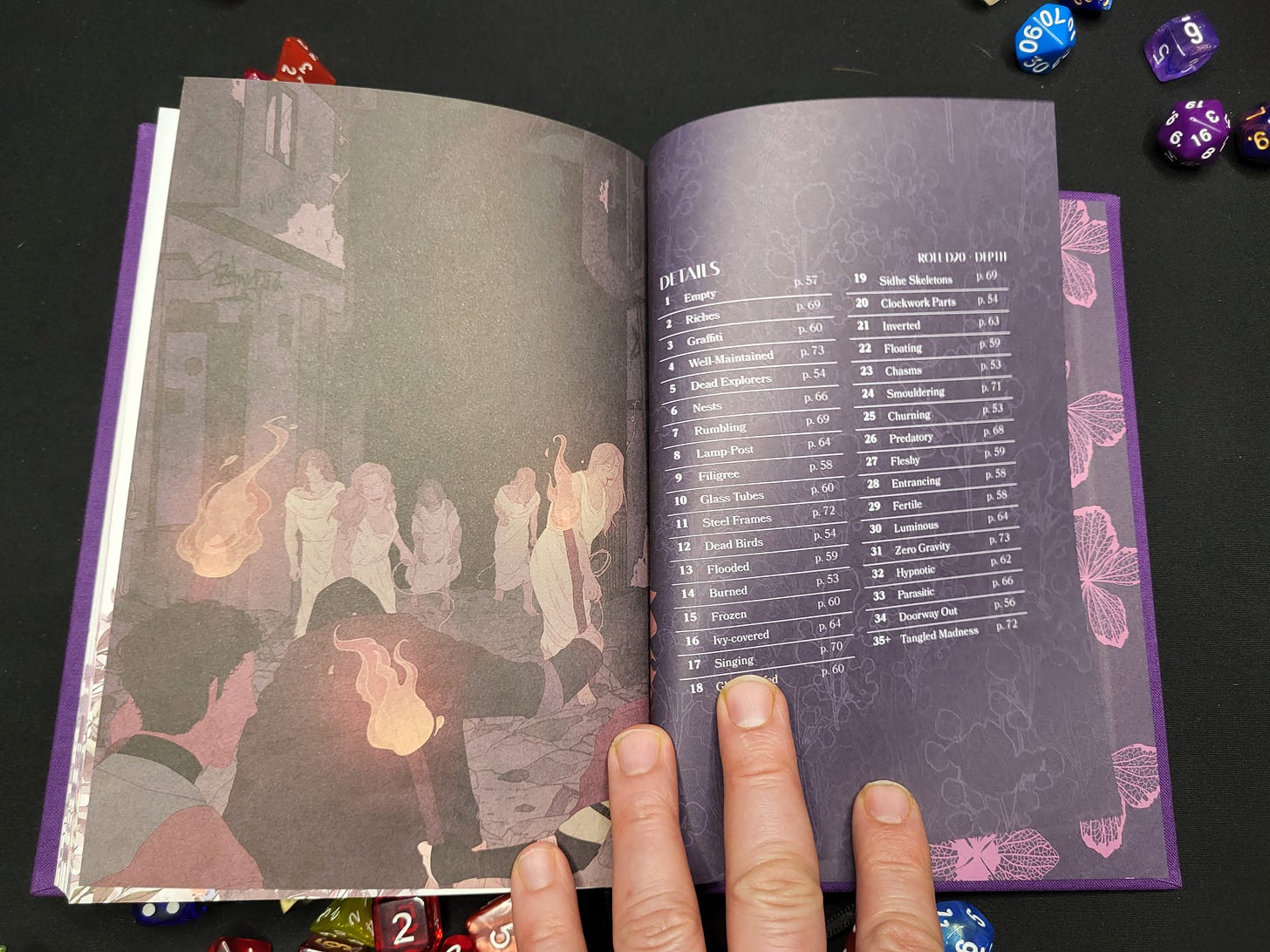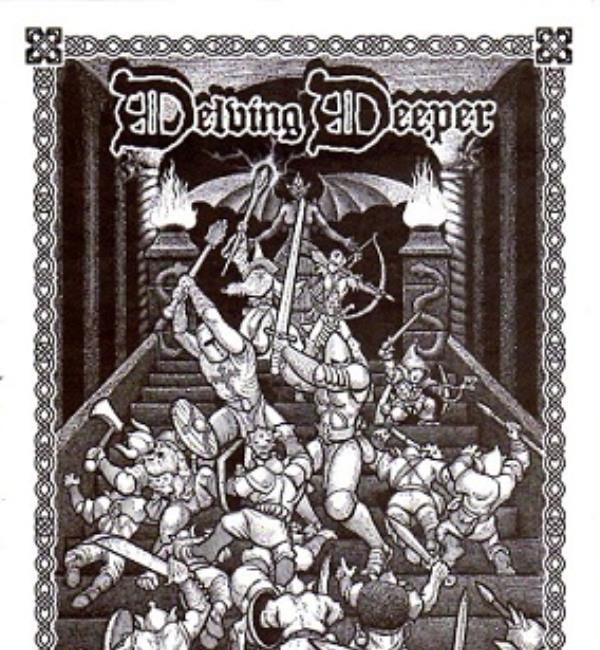Welcome to the Glyph and Grok - A weekly blog-letter exploring topics in the tabletop gaming arena. We explore design, execution, and culture relating to anything played on a tabletop. For other game reviews, see our section here.
“When it is opened… Infinite, overgrown, extradimensional. This realm is full of magic and treasure, worthy of exploration, and plunder by sellswords, occultists, and adventures."
On The Tin
OSR, old school system neutral
Cloth bound 160 page hardcover book
“Depth-crawl” point crawl system developed by this author
Well laid-out for easy reading and reference
Thematic aesthetic and excellent art
A built in bookmark! (always a plus)
Introduction
My first interaction with the Gardens of Ynn was finding the Kickstarter in the first quarter of 2024. The project funded and did quite well at selling the concept and blowing out the target goal. The original text looks like it was created back in 2019, and this KS was for creating the artifact of a hardcover book.
I’m always looking for interesting settings both to play games in and read through to give me examples of well-executed ideas that I may create in the direction of.
In reading through the book, the media I have experienced that is listed in the Appendix N came singing through. The feel is a generated jaunt into a combination of Narnia and Wonderland with elements of a Studio Ghibli film.
As stated in the introduction of the book itself, it is intended as a bolt-on mega-dungeon-esque addition to drop into any setting and more of a well fleshed out point-crawl than a fully fleshed out setting unto itself, but it certainly has enough going on to generate many session of play.
Out in the daylight, just a little…off…
The Basics
The aesthetics feel like the delivery of a singular vision. Not every piece of it is personally my favorite, but it certainly feels like a complete product delivered with an eye for pleasing weirdness. The tactile feel of the outer cover and the pages are rough to the touch, while the decoration, fonts and pastel color pallet all serve to create a softer, calmer experience. This dichotomy serves the book well, and catches you off guard when you read certain brutal entries of what some of the traps, hazards, or benefits tables suggest. It feels like a book you’d pull off the shelf in a strange other-worldy library and sit in a leather chair served tea by some insect-person. The Gardens of Ynn are alien and exist in a serene forgotten natural balance with some clockwork machinations keeping the liminal space going long after the creators have abandoned it.
Pretty cool.
The sections of the book are as follows:
Introduction
Locations
Location Details
Bestiary
Useful tables
Book Introduction
As someone who is always looking for more answers to the question “How does one make TTRPG exploration more fun?” Any text that is attempting to generate interesting exploration gameplay will have my attention. Specifically there is a fun creative space in the implementation of exploration rules while they are untethered to a specific rule-set. Of course they exist in this larger realm of old school D&D, but the lines are very blurry. In trying to write my own versions of these things, I’ve often gotten lost in the truth that generating anything like this requires decisions about the setting. Even if all you do is provide tables to the reader, there is a suggested setting that will come about, and if you don’t control what is presented, it can come across unintentionally vague and feel like it isn’t a real place with a life of its own. This book does not have a problem in this regard.
This text follows one my favorite things about reading well-written OSR settings documents, it just gets to the point. In a matter of about twenty excellently spaced and decorated pages, it lays out what the Gardens of Ynn are, how players enter them, how to procedurally generate the points of the point-crawl, and how to handle situations that will certainly come up like rushing or exploring between the points with intention, or getting lost - and in a way that feels simple to understand and implement at the table.
Random encounters are a D20 table, not a D100, and they’re built so that the first 12 are creature encounters that suggest the players are moving quickly and not paying attention - so they won’t find any secrets randomly if you’re rolling a D12 to simulate they are moving quickly. I’d not thought to build an encounter table like this before and it’s makes alot of sense for creating a feeling in exploration and making a table flexible without adding any overhead to the GM.
Locations
The locations are the meat of the interesting stuff of this book. These places that are travelling between and act as the points of the “point” crawl or “depth” crawl are dripping with story opportunity and when one of these locations has need of rules to test the characters for possible bad outcomes, the OSR stylings of using the player character’s sheet to create resource pools for anything that comes to mind are very interesting to me.
Need to see how long it takes for characters to get through a maze? How does this work in 5E? A survival check against a DC? Not very exciting or nuanced.
How about in Ynn? Roll a D20 each round (10 minutes) of moving in the maze, values rolled under the character’s intelligence are tallied, rolls above intelligence stat are ignored - once the tally hits 50 the maze if solved and the character reaches the center. This is a cool way to do this that accounts for the stat of the character and has some variability in how long it takes without taking the life out of the event. And random encounters are rolled as you go and will be more of an exciting hurdle, rather than a slog of a 3 hour combat that makes you forget you’re in a hedge maze to begin with.
These kinds of rules-lite entries are in many of the locations and can make for fair but deadly situations where player characters are given enough rope to hang themselves.
Bestiary
The creatures drip with the strange off-ness you’d expect from a being dropped into a dangerous wonderland. The specific creatures are thematic and interesting and I didn’t find any generic goblins milling about. But the specific creatures are not as interesting as the ability to make simple stat blocks interesting through their practical suggested interactions. The OSR formula of Hit dice, HP, Armor, Attacks, Saves can make for a really slick and streamlined stat line, but to make it interesting the creature has to be and again the open format allows for the author to just asserts a “save” interaction and it both makes sense and doesn’t take much text to convey. Like the locations, the creatures have their own little quirks that all seem much easier to keep in mind for actual gameplay than staring at a large 5E statblock.
I’m sure there are many OSR settings and books that do this well, but I see it done well here so I am calling it out.
Conclusion
I was not sure when I backed this book on Kickstarter that I would enjoy it. I thought at the time I was taking a chance, but I am glad I just went for it, because I really like this book as a whole. This is not a product I would make, but I am very glad I have it. It feels like a small artifact from another time and place. AND it is actionably useful to an ongoing tabletop campaign.
Even if you don’t use the exact stats or effects in just the way presented by the book, it has some very cool ideas and presents a fairy world in a way I really like. Alot more old-school fairy tale, old school brother’s grimm, where the weirdness is potent and dangerous.
If you find yourself running any kind of table top game in a fey, fae, fairy locale, you will find something of use here.
Till next time!
Where To Purchase
Soul Muppet Publishing Website
Related Reading
Thanks for Reading!
Please like, share, and comment your thoughts!

